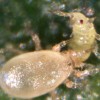Abstract
Amblyseius is a beneficial predatory mite endemic to the Eastern Mediterranean region. This species is considered a generalist predator, and readily consumes small soft-bodied pest species as well as pollen or plant exudates. Amblyseius swirskii has attracted substantial interest as a biological control agent of mites, thrips and whiteflies in greenhouse and nursery crops and is currently reared and sold commercially in Europe and North America for this purpose. This 5-page fact sheet was written by Mahmut Dogramaci, Garima Kakkar, Vivek Kumar, Jianjun Chen, and Steven Arthurs, and published by the UF Department of Entomology and Nematology, June 2013.
References
Arthurs S, McKenzie CL, Chen J, Doğramaci M, Brennan M, Houben K, Osborne L. 2009. Evaluation of Neoseiulus cucumeris andAmblyseius swirskii (Acari: Phytoseiidae) as biological control agents of chilli thrips, (Thysanoptera: Thripidae) on pepper. Biological Control 49: 91-96. https://doi.org/10.1016/j.biocontrol.2009.01.002
Buitenhuis R, Shipp L, Scott-Dupree C. 2010. Dispersal of Amblyseius swirskii Athias-Henriot (Acari: Phytoseiidae) on potted greenhouse chrysanthemum. Biological Control 52: 110-114. https://doi.org/10.1016/j.biocontrol.2009.10.007
Calvo FJ, Bolckmans K, Belda JE. 2011. Control of Bemisia tabaci and Frankliniella occidentalis in cucumber by Amblyseius swirskii. Biocontrol 56: 185-192. https://doi.org/10.1007/s10526-010-9319-5
Cedola C, Polack A. 2011. First record of Amblyseius swirskii (Acari: Phytoseiidae) from Argentina. Revista de la Sociedad Entomologica Argentina 70: 375-378.
Chen X, Zhang Y, Ji J, Lin J. 2011. Experimental life table for population of Amblyseius swirskii (Athias-Henriot) fed on Tetranychus truncatus (Ehara). Fujian Journal of Agricultural Sciences 3: 018
Colomer I, Aguado P, Medina P, Heredia RM, Fereres A, Belda JE, Vinuela E. 2011. Field trial measuring the compatibility of methoxyfenozide and flonicamid with Orius laevigatus Fieber (Hemiptera: Anthocoridae) and Amblyseius swirskii (Athias-Henriot) (Acari: Phytoseiidae) in a commercial pepper greenhouse. Pest Management Science 67: 1237-1244. https://doi.org/10.1002/ps.2173
Croft BA, Blackwood JS, McMurtry JA. 2004. Classifying life-style types of phytoseiid mites: diagnostic traits. Experimental and Applied Acarology 33: 247-260. https://doi.org/10.1023/B:APPA.0000038622.26584.82
Doğramaci M, Arthurs S., Mckenzie CL, Chen J, McKenzie C, Irrizary F, Osborne, L. 2011. Management of chilli thrips Scirtothrips dorsalis (Thysanoptera: Thripidae) on peppers by Amblyseius swirskii (Acari: Phytoseiidae) and Orius insidiosus (Hemiptera: Anthocoridae). Biological Control 59: 340-347. https://doi.org/10.1016/j.biocontrol.2011.09.008
EPPO (European and Mediterranean Plant Protection Organization). 2013. Commercially used biological control agents - Arachnida, Acarina. (13 June 2013).
Juan-Blasco M, Qureshi JA, Urbaneja A, Stansley PA. 2012. Predatory mite, Amblyseius swirskii (Acari Phytoseiidae), for biological control of asian citrus psyllid, Diaphorina citri (Hemiptera: Psyllidae). Florida Entomologist 95: 543-551. https://doi.org/10.1653/024.095.0302
Kade N, Gueye-Ndiaye A, Duverney, C, Moraes G. J. 2011. Phytoseiid mites (Acari: Phytoseiidae) from Senegal. Acarologia 51: 133-138. https://doi.org/10.1051/acarologia/20112001
Kakkar G, Kumar V, Seal DR, Liburd OE, Stansly P. 2016. Predation by Neoseiulus cucumeris and Amblyseius swirskii on Thrips palmi and Frankliniella schultzei on cucumber. Biological Control 92: 85-91. https://doi.org/10.1016/j.biocontrol.2015.10.004
Kumar V, McKenzie CL, Avery PB, Osborne L. 2016. Ornamental pepper banker plants: Can we bank on them? Pest Management Science (in press).
Lee HS, Gillespie DR. 2011. Life tables and development of Amblyseius swirskii (Acari: Phytoseiidae) at different temperatures. Experimental and Applied Acarology 53: 17-27. https://doi.org/10.1007/s10493-010-9385-5
Messelink GJ, Van Steenpaal EF, Ramakers PMJ. 2006. Evaluation of phytoseiid predators for control of western flower thrips on greenhouse cucumber. BioControl 51: 753-768. https://doi.org/10.1007/s10526-006-9013-9
Nomikou M, Janssen A, Schraag R, Sabelis MW. 2001. Phytoseiid predators as potential biological control agents for Bemisia tabaci. Experimental and Applied Acarology 25: 271-291. https://doi.org/10.1023/A:1017976725685
Onzo A, Houedokoho AF, Hanna R. 2012. Potential of the predatory mite, Amblyseius swirskii to suppress the broad mite,Polyphagotarsonemus latus on the gboma eggplant, Solanum macrocarpon. Journal of Insect Science. 12: 7. Available online: insectscience.org/12.7 https://doi.org/10.1673/031.012.0701
Opit GP, Nechols JR, Margolies DC, Williams KA. 2005. Survival, horizontal distribution, and economics of releasing predatory mites (Acari: Phytoseiidae) using mechanical blowers. Biological Control 33: 344-351.
https://doi.org/10.1016/j.biocontrol.2005.03.010
Park HH, Shipp L, Buitenhuis R. 2010. Predation, development and oviposition by the predatory mite Amblyseius swirskii (Acari: Phytoseiidae) on tomato russet mite (Acari: Eriophyidae). Journal of Economic Entomology 103: 563-569. https://doi.org/10.1603/EC09161
Park HH, Shipp L, Buitenhuis R, Ahn JJ. 2011. Life history parameters of a commercially available Amblyseius swirskii (Acari: Phytoseiidae) fed on cattail (Typha latifolia) pollen and tomato russet mite (Aculops lycopersici). Journal of Asia-Pacific Entomology 14: 497-501. https://doi.org/10.1016/j.aspen.2011.07.010
Ragusa S, Swirski E. 1975. Feeding habits development and oviposition of the predaceous mite Amblyseius swirskii Acarina Phytoseiidae on pollen of various weeds. Israel Journal of Entomology. 15: 55-62.
Sato Y, Mochizuki A. 2011. Risk assessment of non-target effects caused by releasing two exotic phytoseiid mites in Japan: can an indigenous psytoseiid mite become IG prey? Experimental and Applied Acarology 54: 319-329.
https://doi.org/10.1007/s10493-011-9455-3
Stansly PA, Castillo JA. 2010. Control of broadmites, spidermites, and whiteflies using predaceous mites in open-field pepper and eggplant. Proceedings of the Florida State Horticultural Society 122: 253-257.
Wimmer D, Hoffman D, Schausberger P. 2008. Prey suitability of western flower thrips, Frankliniella occidentalis, and onion thrips,Thrips tabaci, for the predatory mite Amblyseius swirskii. Biocontrol Science and Technology 18: 533-542. https://doi.org/10.1080/09583150802029784
Xiao YF, Avery P, Chen JJ, McKenzie C, Osborne L. 2012. Ornamental pepper as banker plants for establishment of Amblyseius swirskii (Acari: Phytoseiidae) for biological control of multiple pests in greenhouse vegetable production. Biological Control 63: 279-286. https://doi.org/10.1016/j.biocontrol.2012.09.007
Unless otherwise specified, articles published in the EDIS journal after January 1, 2024 are licensed under a Creative Commons Attribution-NonCommercial-NoDerivs 4.0 International (CC BY-NC-ND 4.0) license.

